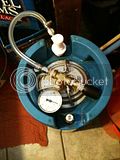Lennie
Well-Known Member
I just finished a 15 gallon ferment in a sanke and I went the airlock route for the first three days then installed my pressure rig. It was a pilsner in budvar yeast and it was a violent fermentation. Finished product came out great and is currently in the kegerator.
What temp did you ferment at? I don't have much temp control on my unit so I'm sticking to ales right now. I put a box fan blowing on the Brewhemoth conical in the basement and I can keep the ferm at 66-68F at the peak of activity, I doubt this is good enough for a lager and I hate to gamble with 15gal of beer.




